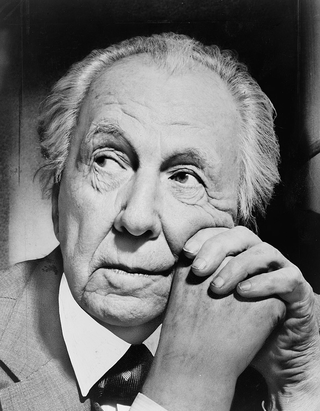Divorce
Anatomy of an Egotist
Architect Frank Lloyd Wright exhibited many all-too-familiar traits.
Posted October 20, 2019 Reviewed by Gary Drevitch
Frank Lloyd Wright, the best-known architect in American history, was not bashful about self-promotion. Once he reported that, early in life, he faced a choice between honest arrogance and hypocritical humility. Said Wright, “I chose the former and have seen no reason to change.” So confident was he in his own aesthetic judgment that he advised that both Boston and Pittsburgh be depopulated.

A recent visit to Wright’s Taliesin West winter home and architecture school in Scottsdale, Arizona, rekindled my fascination with his remarkable story and legendary self-regard. Wright illustrates many traits of character that seem all too prevalent among the celebrated and reviled of our own day, providing timeless insight into egotistical patterns of thought and behavior.
Wright’s Biography
Wright was born in 1867 in Wisconsin. He loved to tell the tale that, before he was born, his mother prophesied that he would build great buildings, decorating his nursery with engravings of English cathedrals to serve as inspiration. He also recalled that she bought him a set of building blocks that he studied and played with frequently as he was growing up.
Wright liked to report that he “nearly graduated” from the University of Wisconsin, though he actually took classes only part-time for two semesters. He left without a degree, though Wisconsin would grant him an honorary doctorate in 1955. Wright eventually joined the prominent Chicago architecture firm of Adler and Sullivan, where Sullivan signed him to a five-year contract.
Wright rose quickly to the rank of head draftsman, but his spendthrift ways, which dogged him all his life, left him chronically short of funds. To compensate for his expensive tastes, he accepted independent commissions for numerous houses. Soon after Sullivan discovered that Wright was violating his contract, his services were terminated.
Out on his own, Wright eventually moved his practice into his Oak Park home, which he and his first wife, Kitty, filled with six children. In 1903, Wright fell in love with the wife of one of his clients, Mamah Cheney, and in 1909, the two abandoned their families and escaped to Europe. When they returned, scandal precluded living in Oak Park, so Wright persuaded his mother to buy land in Wisconsin.
There Wright built a new home, which he named Taliesin, a Welsh word that means “shining brow.” In 1914, while Wright was in Chicago, a laborer set fire to the house and murdered seven people with an ax, including Mamah and her two children. When Wright’s first wife finally granted him a divorce in 1922, he was required to wait one year before remarrying.
He married his second wife, Miriam Noel, the next year, shortly after his mother’s death. However, Miriam struggled with drug addiction, and the marriage foundered. Soon Wright met his third wife, Olgivanna, and their daughter was born in 1925. Divorced from Noel in 1927, Wright was able to marry her in 1928. They soon established Taliesin West in Arizona.
As an architect, Wright’s contributions are unassailable. A house he designed in Pennsylvania, Fallingwater, is often regarded as the greatest work of American architecture. Over a working life of more than 70 years, he founded the Prairie School, wrote more than 20 books, and was recognized in 1991 as the all-time greatest American architect. Just this year, Taliesin was recognized as a World Heritage Site.
Wright’s Character
In addition to those already mentioned, there are many reasons to question Wright’s character. He appears to have lied about his age. He feigned disdain for publicity, but courted it assiduously, exhausting photographers attempting to produce an image he was happy with. Wright spent lavishly on luxury goods, including over 80 automobiles—many of which were collectibles—but proved infamously resistant to paying his bills.
Broke after years of living beyond his means, he required architecture students in his Taliesin Fellowship to farm the land, cook, and clean, and construct his buildings, all while paying the then-exorbitant sum of $700 in annual tuition. Alumni reported that Wright and Olgivanna even attempted to control the students’ romantic lives, rotating female students among the males.
At least on the outside, Wright was staggeringly self-confident. It is said that once when called to testify in a court of law, he was asked to state his name and occupation.
He responded, “Frank Lloyd Wright, the world’s greatest architect.”
Later his wife suggested he should avoid such boasting. He replied, “I had no choice, Olgivanna. I was under oath.”
Wright was notoriously loath to admit error, technical or moral. He did not apologize when the building he designed for Johnson Wax turned out to cost six times the price he quoted, nor when the president called him to report that, during a dinner with distinguished guests, the new building’s roof was leaking right onto his table. Instead, Wright suggested that he move his chair.
When Wright was confronted with untruths he had propagated, his characteristic response was only, “Well, there you are. . .” before moving on quickly to another subject. It is noteworthy that Wright was the inspiration for Howard Roark, the protagonist of the 1943 novel The Fountainhead, by Ayn Rand, whose writings zealously promoted what she called “the virtue of selfishness.”
Egotism
Wright beautifully illustrates many features of egotism, including an inflated sense of self-importance, a great need for attention and admiration, troubled relationships, and little empathy for the suffering of others. In many cases, beneath such celestial self-regard lies a fragile sense of self-esteem that cannot bear even the slightest criticism.
Many readers will see similarities between Wright and other prominent figures of our own day. Working and living with such individuals is not easy, because they typically exhibit no insight. In their eyes, their gifts, accomplishments, and charm are far beyond reproach, and any collateral damage their greatness inflicts on others inevitably seems inconsequential.




